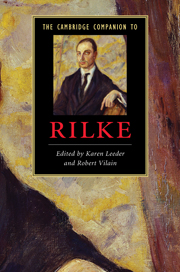2 - The status of the correspondence in Rilke’s work
from PART I - LIFE
Published online by Cambridge University Press: 28 July 2010
Summary
Rainer Maria Rilke's vast correspondence touches upon the full range of topics addressed in his poetry and prose. In what amounts to approximately 17,000 letters (not all of them yet published due to copyright restrictions with addressees), Rilke sometimes abandoned the constraints of German verse, and occasionally syntax, to produce powerful and surprisingly accessible meditations on life, art, death, religion, love and politics. Rilke wrote to housekeepers and politicians, fellow poets and lovers, teenage girls infatuated with his verse and, though rarely, to critics who had engaged with his work. The only criterion for inclusion in Rilke's little black book, where he meticulously kept track of all his correspondence (at the end of his life, it contained several hundred entries with notes on every letter written and received), was that a letter, even from an unknown individual or someone of far lower social standing, 'spoke to him'. Rilke took each word in every letter seriously, as can be gleaned from the immaculate way he covered pages and pages of stationery with his prose. A little over a year before his death in a Swiss sanatorium, Rilke stipulated in October 1925 that his letters ought to be published alongside his other writings: 'Since for now several years I have had the custom to channel part of the productivity of my nature into writing letters, there exist no obstacles to publishing my correspondence [ . . . ] (should my publisher Insel Verlag make such a suggestion)' (Briefe, II, 1192). Given the profundity of thought expressed in his letters and Rilke's own high estimation of these missives, it is virtually impossible to gain a full understanding of the poet without taking the correspondence into account.
- Type
- Chapter
- Information
- The Cambridge Companion to Rilke , pp. 27 - 38Publisher: Cambridge University PressPrint publication year: 2010



